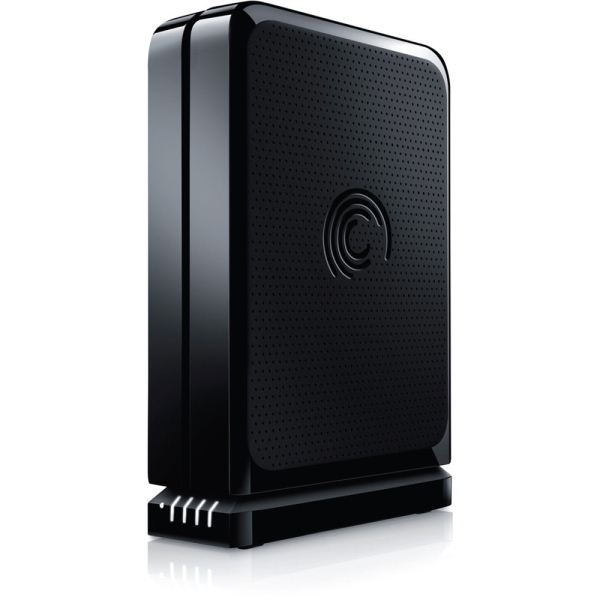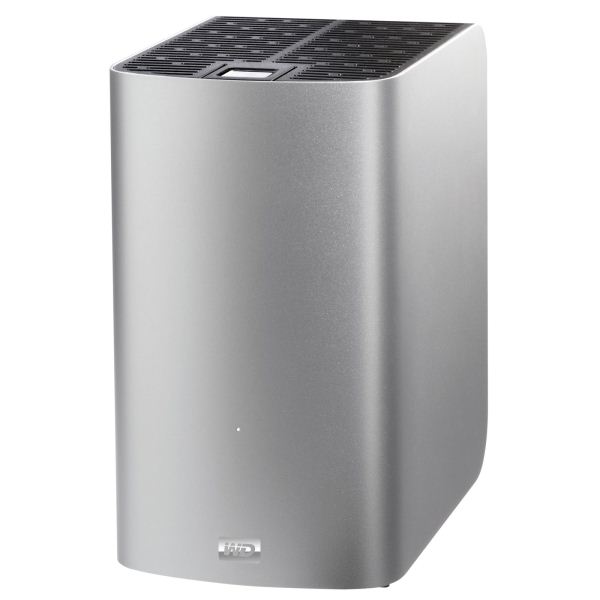A Tale Of Two Thunderbolt Storage Devices: Seagate's GoFlex Desk and Western Digital's Thunderbolt Duo
by Brian Dipert on May 13, 2012 7:52 PM EST- Posted in
- Thunderbolt
- Seagate
- WD
- Western Digital
I remember the early days of the USB-vs-FireWire wars like they were yesterday, although Wikipedia reminds me that they were more than a decade ago (sigh). USB 1.0 arrived in 1996 but didn't begin to see broad adoption until two years later with version 1.1. When FireWire 400 (aka IEEE 1394a) emerged on Apple systems in 1999, its backers scoffed at USB's comparatively diminutive 11 Mbps peak (and much lower practical) bandwidth.
Intel and its partners' response was swift; USB 2.0 came on the scene in 2000. Its 480 Mbps theoretical peak bandwidth, coupled with Intel's refusal to integrate FireWire support within its core logic chipsets, doomed FireWire to niche status in spite of the subsequent emergence of the 800 Mbps IEEE 1394b variant.
Yet as anyone who's used a USB 2.0 hard drive or flash drive knows, the external bus's read and write performance still leave a lot to be desired, especially for video and other large-file-size material. eSATA attempted to address the issue, but its storage-centric focus left OEMs unwilling to adopt it en masse, from both incremental-cost and incremental-connector perspectives. What the industry wanted was an equally versatile but speedier successor to USB 2.0...
...and now it's got two. Yep, another standards war - except not in the traditional sense, these two are complementary. The USB 3.0 specification was released in late 2008, with first products available beginning one year later. Designed primarily as a replacement for USB 2.0, it delivers 4.8 Gbps transfer speeds, along with discrete transmit and receive data paths. And courtesy of Intel's Ivy Bridge integration, USB 3.0 will soon become pervasive in a diversity of PC platforms and form factors. But more than a year ago, Intel and partner (and customer) Apple productized a copper-based version of an Intel-proprietary interface called Thunderbolt, formerly known as Light Peak.
Each Thunderbolt port handles 40 Gbps of aggregate bandwidth, consisting of two pairs' worth of distinct 10 Gbps transmit and receive lanes. Thunderbolt isn't so much about enabling the connection of discrete storage devices (although it has been used for just that by many early peripherals), but new PC form factors instead. If you have to give up GigE, Firewire 800 and a gigantic screen to build a sleek Ultrabook, Thunderbolt will give you access to those things via an external display. Did I mention that Thunderbolt carries DisplayPort as well as PCIe?
To date Thunderbolt has mostly only appeared on Macs, but the Apple exclusivity period is now over. This year we'll see the emergence of more affordable second-generation controller ICs, resulting in Thunderbolt showing up in a diversity of PC platforms and form factors.
Anand has done several in-depth Thunderbolt peripheral reviews so far:
- Promise Pegasus R6 & Mac Thunderbolt Review (7/8/2011)
- The Apple Thunderbolt Display Review (9/23/2011)
- LaCie Little Big Disk (2TB) Review: More Affordable Thunderbolt Storage (10/31/2011)
- LaCie Little Big Disk (240GB SSD) Review (11/8/2011), and
- LaCie 2big Thunderbolt Series Review (2/25/2012)
Today we've got two more products up for evaluation; Seagate's 2 TByte GoFlex Desk HDD coupled with the company's just-in-production Thunderbolt Adapter:
and Western Digital's two-HDD Thunderbolt Duo.
Let's have a look, shall we?












46 Comments
View All Comments
Death666Angel - Wednesday, May 16, 2012 - link
This sentence is a bit misleading:"a specific RPM at any particular time is dependent on both access requirements and sensed operating temperature." - This would suggest that this HDD runs with varying RPMs. This is not true. One HDD runs with one RPM. However, between the various HDDs among one charge there can be different RPM settings. So one Caviar Green "IntelliPower" runs with 5400 while the next runs with 5900. You will not see one 5400 unit suddenly run at 5900 because the temperatures are particularly low.
bdipert - Saturday, May 19, 2012 - link
Dear Death666Angel, I don't think you're correct. WD has told me on many occasions that the IntelliPower algorithm varies a drive's rotational speed over time as a function of performance demand and operating temperature. And past AnandTech writeups make similar statements:http://www.anandtech.com/show/2385/2
for example
wolfgang123usa - Thursday, July 12, 2012 - link
The real advantage of Thunderbolt should be that it carries power, but special this feature is very limited, as the power pin on the connector is very small and shall carry 10Watts, Sata connectors, USB and other have bigger contact surfaces and/or multiple pins to carry power. The display port adapter was designed for a lot less power then 10watts, that's the current issue with Thunderbolt today. Some details can be found here:http://technology.coolodman.com
When a self powered thunderbolt device is used it works fine and uses only about 22% overhead to encapsulate the PCIe bus, so the speed with fast SSD's like Samsung 830 series is really not bad.
marmot_animal - Friday, July 13, 2012 - link
Two months after this article was written, I find Thunderbolt options at the same phase, quite limited. So I bought the Seagate GoFlex Thunderbolt adapter for $$$ from B&H, plus the cable. Although expensive, it seems for the time being the least expensive approach, albeit a DIY approach, to use raw hard drives, of which I have an expanding collection for my video and audio projects.If my research is correct, there are no official generic Tbolt docks, unlike the common USB3 (and earlier interfaces) docks on Tiger Direct. Although LaCie 2big bays appear to physically allow users to swap raw hard drives, LaCie voids the warranty in doing so. Obviously LaCie discourages a DIY approach and of course favors consumers to procure LaCie's aftermarket harddrive-installed bays. This is less of a diehard obstacle as opposed to WD's Caviar requirement. Conversely, I'm not into opening up enclosures to swap drives. It requires tools, is time-consuming, and is semi-permanent. My preference is to swap raw drives on-the-fly.
At least the GoFlex DIY hacker method works, and I secure the drive on the dock via rubber band technology. I report 'so far so good' with raw drives. I don't know precise speed details as long as I'm able to put the Tbolt bus to use, and it appears faster than any other bus I've used with FCPX. Too many companies try to hijack Tbolt by instilling proprietary constraints. Nevertheless, I find the GoFlex design with its generic SATA interface to be an extremely niche approach because most consumers won't want to seat a raw hard drive somewhat precariously in a dock not designed for such use.
spanading - Saturday, October 6, 2012 - link
Honestly peps,Why are people compairing the two. Yes USB is great if you are conneting things like HHD, Mice, Tablets, and the like, but remember you only have 5Gb in a single channel, one way maximum to play with, while thunderbolt has 20Gb when using both channels. True neither USB 3 nor Thunderbolt would be maxed out by a single HDD, but when connecting several data hungry devices at once, (which with thunderbolt can include monitors, and possible legacy port hubs, if they ever arrive) then USB will show the strain a lot quicker than thunderbolt.
Hence why you need a thunderbolt port? Well if all you are doing is plugging in one HHD over it it is probably overkill, BUT, if you like to have one of those new shiny Ultra books to use on the run but then want a fully fledged PC when you get home, Thunderbolt gives you this potential, but only having to connect 1 cable, rather than 3 or 4. Plus with it being compatible with PCi then you can have expansion cards to further enhance performance with out the need for a completely separate PC. Now before you complain ultra books have low spec CPUs, go and play with one that uses a SSD and see how much speed a traditional HDD sucks up while the system waits for data. As an example, my 2011 Mac book air has a 1.7 GHz dual core i5 with integrated graphic and only 4GB of memory, and on day to day tasks, is faster than my 2011 mac min server with a 2.0Ghz Quad core i7 with the same integrated graphics but 16 GB of RAM. In fact my macbook only struggles when the RAM is all used up, which is not very often .
I guess this is exactly what Dan Neely meant. Good on you Dan, I guess the USB people have not quite grasped the fundamental difference yet.
biswa60 - Saturday, October 19, 2019 - link
Each Thunderbolt port handles 40 Gbps of aggregate bandwidth, consisting of two pairs' worth of distinct 10 Gbps transmit and receive laneshttps://theprintcalendar.com/
https://vicschoolholidays.com/